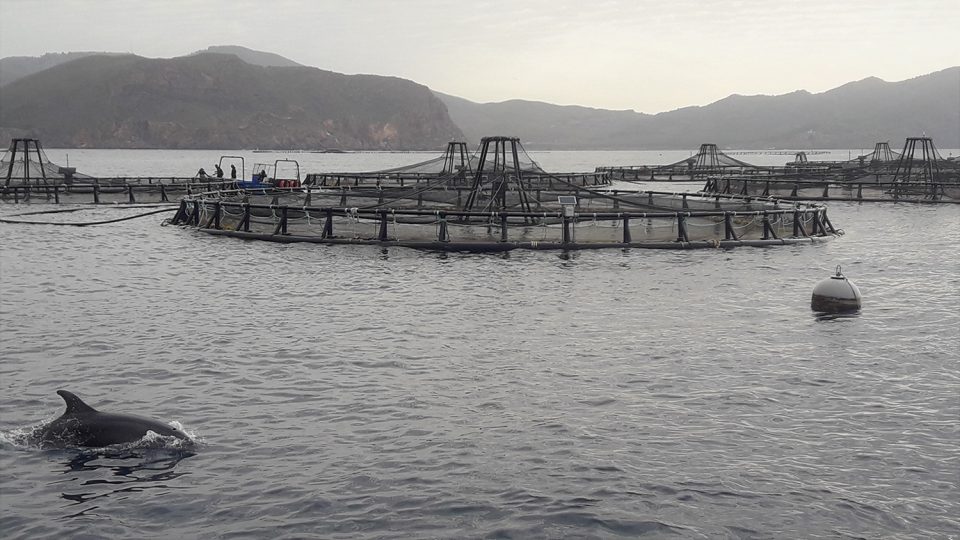Through the GAIN project, Spanish facility’s farm management, decision-making are taken to a new level

This article continues our series on “precision aquaculture,” part of a larger three-part series on sustainable aquaculture intensification in Europe, focused on precision aquaculture, sustainable feeds and circular economy. This work from the GAIN project is funded by the EU Horizon 2020 Fund. Each part in this series takes provides an introductory glance at the three topics, then explains how outputs from the GAIN project are contributing towards it, including the applicability to industry and governance.
Farm managers at “El Gorguel,” a sea bass farm in southern Spain, implemented sensors for precision aquaculture. While daily monitoring of the sensors required some initial additional effort by staff, implementing precision aquaculture techniques allowed the farm to 1) receive faster warnings of adverse environmental conditions; 2) improve oxygen and feeding efficiency; and 3) enhance preventative measures against disease.
“My feeding strategy is driven by temperature and oxygen values, so these sensors have become essential tools for our feeding routines,” said Fabián Senent, farm feed manager.
Marina Jimenez, El Gorguel fish health officer, explained that “through the project, those sensors gave me real-time information on environmental parameters, telling me how each pen was seeing its condition change and how this might impact fish health and welfare down the line.”
About the site
Worth approximately €200 million, more than 27,000 metric tons (MT) of European sea bass (Dicentrarchus labrax) and 13,500 MT of sea bream (Sparus aurata) are grown in the Spanish Mediterranean Sea. The Murcia, Valencia, Canarias and Andalusia Regions lead the Spanish bass and bream production. Culmarex Group, a Cooke Company, is the largest producer of Spanish sea bass and bream and a partner in the GAIN project.
Culmarex deployed environmental sensors in its Lebeche farm on the South coast of Spain. The farm grows seabass in offshore pens anchored in the crystal-clear waters of the Mediterranean Sea. Their site “El Gorguel” has two lines of 16 pens, each about 80 meters in circumference. Each cage contains 250,000 to 300,000 sea bass, coming in as 20-gram smolts and harvested at 500 grams over 18 months.
The most important daily operations on farms are feeding and health and welfare monitoring of the stock. A feed boat equipped with silos ensures feed distribution, while surface and underwater cameras allow skilled technicians to monitor feeding. Based on these observations, feeding and distribution rates are fine-tuned using modern software and technologies to maximize performance.
Besides the routine implementation of biosecurity rules on-site, daily welfare checks and detailed observations of the stock behavior are carried out by trained staff and divers, supervised by a dedicated veterinarian in charge of sanitary checks.
Water quality and temperature, dissolved oxygen and salinity, current speed or water stratification are key environmental parameters to take into account in those daily routines. The farm is vast, pens are deep and conditions change continuously. Therefore, good control of environmental conditions requires the deployment of various sensors able to keep track of these temporal and spatial changes.
https://www.aquaculturealliance.org/advocate/precision-aquaculture-part-1-data-and-evidence-based-management/
The impact of precision aquaculture
While daily checks of the sensor’s cleanliness and position, electric and Wi-Fi connection issues in a remote area and regular electronic maintenance required some effort from the staff, precision aquaculture was an investment well worth the efforts. Access to this more sophisticated environmental data took farm management and decision-making process to a new level:
- Alarms notified the technical team of critical values, giving early warnings of adverse environmental conditions (e.g. low oxygen or high chlorophyll) and triggered preventive actions.
- Real-time data on oxygen levels allowed the farm to refine the net changing patterns, where cages with the lowest oxygen values had priority for clean nets.
- Feeding pace and feeding rate were better adjusted to temperature, thermocline and oxygen availability for improved performance.
- The sensors brought invaluable environmental information to the site’s veterinarian, who was able to better anticipate and apprehend health and welfare challenges.
Farm managers reported that “Eighteen months of data recording allowed the determination of previously unknown or unassessed patterns in El Gorguel and the learning is still ongoing!”
This project has received funding from the European Union’s Horizon 2020 research and innovation program under grant agreement N° 773330.
Now that you've finished reading the article ...
… we hope you’ll consider supporting our mission to document the evolution of the global aquaculture industry and share our vast network of contributors’ expansive knowledge every week.
By becoming a Global Seafood Alliance member, you’re ensuring that all of the pre-competitive work we do through member benefits, resources and events can continue. Individual membership costs just $50 a year. GSA individual and corporate members receive complimentary access to a series of GOAL virtual events beginning in April. Join now.
Not a GSA member? Join us.
Authors
-
Philippe Sourd
Senior Veterinarian
Grupo CULMAREX
Lebeche, El Gorguel Farm, Spain -
Mariló Lopez
Head of R&D and new products
Grupo CULMAREX
Lebeche, El Gorguel Farm, Spain -
Marina Jimenez
Health Assistant
Grupo CULMAREX
Lebeche, El Gorguel Farm, Spain -
Alexandra Pounds
Assistant Researcher in Aquatic Food Security
Institute of Aquaculture
University of Stirling


